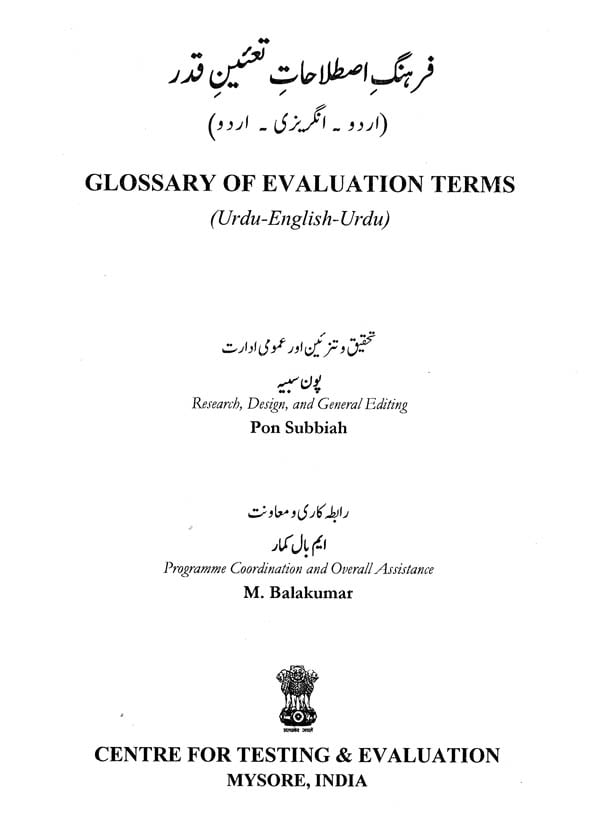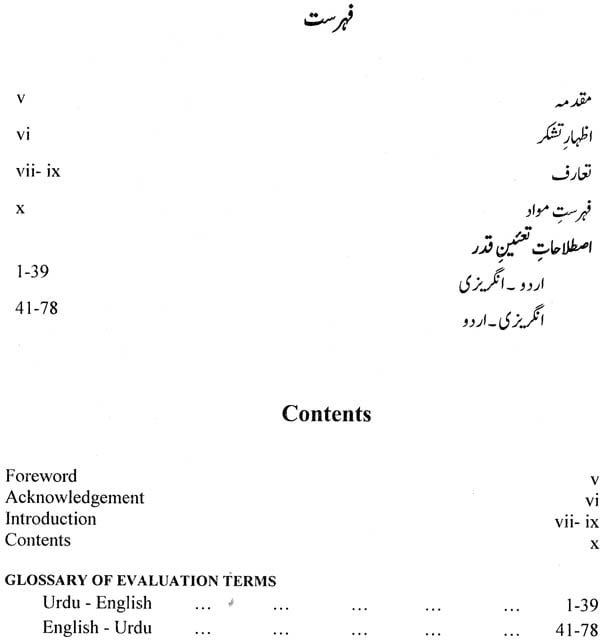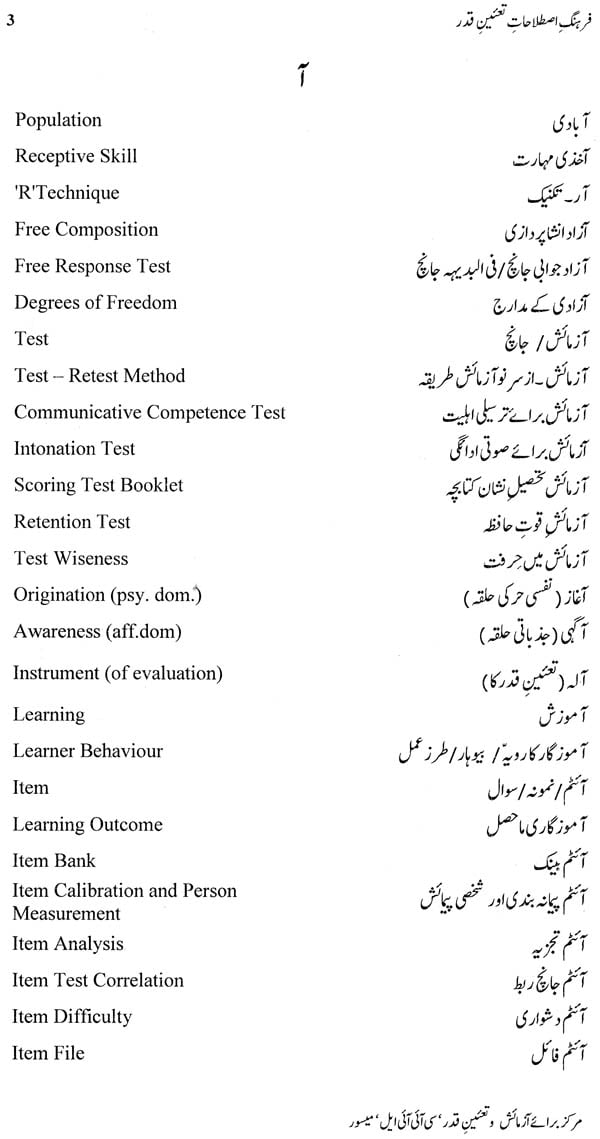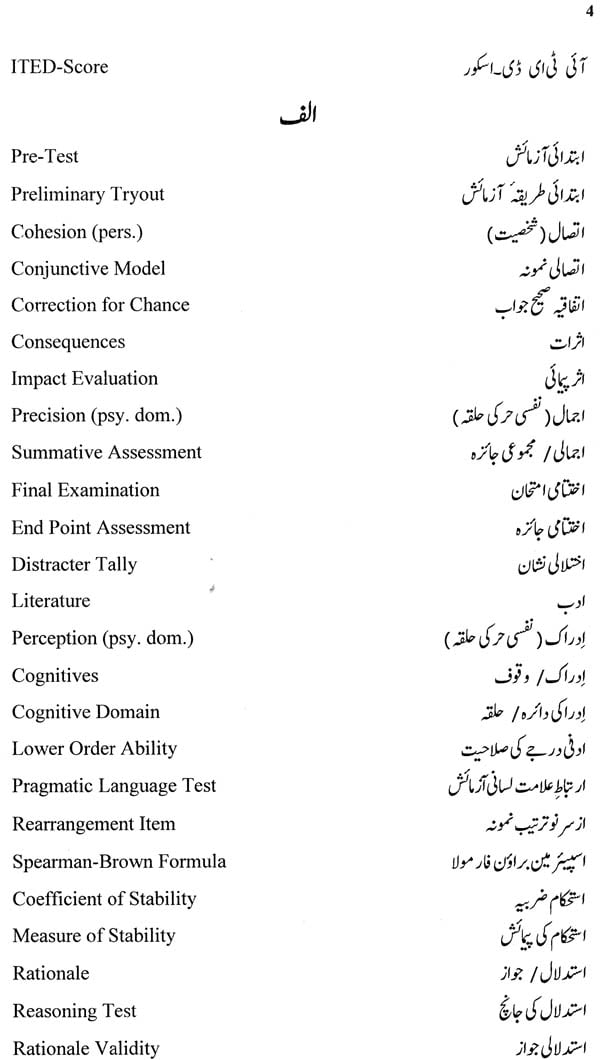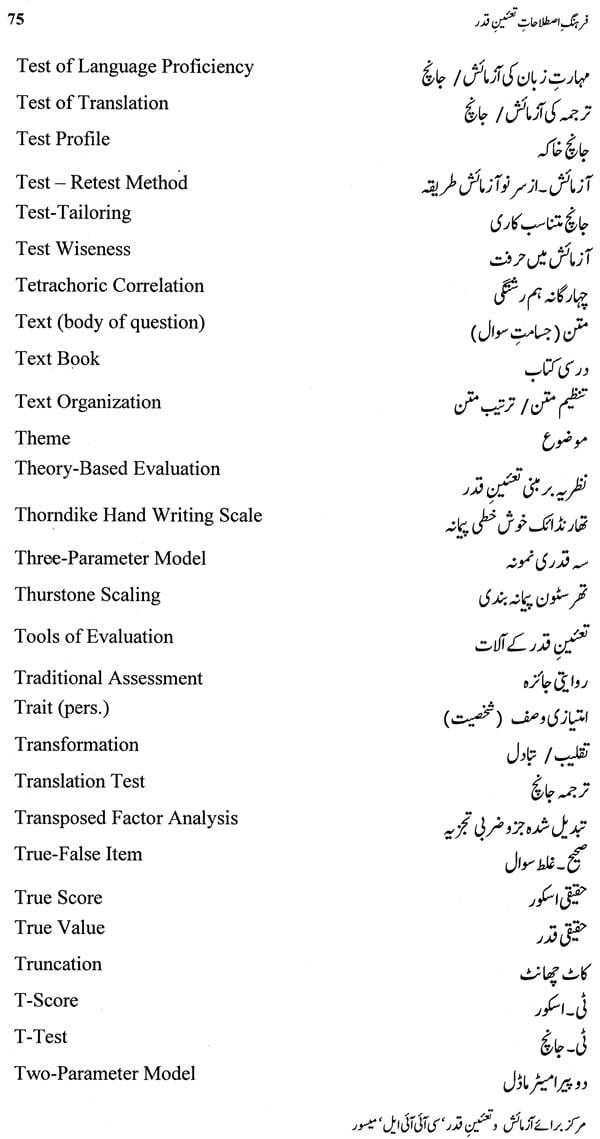
Glossary of Evaluation Terms
Book Specification
| Item Code: | NAW280 |
| Author: | Pon Subbiah |
| Publisher: | Central Institute Of Indian Languages, Mysore |
| Language: | English and Urdu |
| Edition: | 2011 |
| ISBN: | 817342103X |
| Pages: | 94 |
| Cover: | PAPERBACK |
| Other Details | 11.00 X 8.00 inch |
| Weight | 290 gm |
Book Description
The Centre for Testing & Evaluation (CT&E), one of the main R&D units of the Institute, has been actively functioning since 1984. The objective of this centre is to undertake fundamental research, develop basic reference materials, and to coordinate the activities pertaining to this multidisciplinary area of evaluation as applied to language and literature education.
During the last 2 4 decades, the CT&E, has produced more than 100 volumes of materials under different series ranging from 'basic references’ to ‘special purpose assessment tools’ The present reference work consists of two sets of volumes on the same field: The first one Glossary of Evaluation Terms in each of the four Indian languages viz. Hindi, Kannada, Tamil and Urdu with English, and next one Introduction to Evaluation Terminology in each of the above languages, thus making a total of eight volumes.
The 'Glossary' provides equivalents in Hindi / Kannada / Tamil / Urdu for about 1000 evaluation terms in English (that represent the multidisciplinary concepts of education, psychology, statistics, etc.). The ‘Introduction’ provides a brief explanatory note on each of these concepts. The original source for both these works is the Institute's publication viz. 'An Introduction to Evaluation Terminology’ in English authored by Pon Subbiah.
The present set of materials has been developed to supplement the ongoing work of MILES & NTS projects. As the terminology parallels included here demand consensus for their appropriateness and adaptability, the specialists have played a decisive role in coining and finalizing them. Our congratulations are due to all those specialists.
This challenging task has been accomplished after a series of deliberations over a period of time. The relentless effort put up by the team headed by Prof. Pon Subbiah deserves appreciation. I am sure this will go a long way to enrich the Indian language Pedagogy and also to encourage the production of specialised materials in Indian languages.
Language needs content for its operation; content needs a language for its communication. If the content is well defined, the language used is to be compatible enough to convey it. Similarly, if the language is well developed, the content used is to be capable of providing adequate operational contexts. Thus, language and content are mutually exclusive and complementary to each other. But at the same time, both are dependent on the community of people with whom they are associated. If the community is lacking behind in nurturing any of these two, it will have an adverse effect on the other one too. In order to overcome this lacuna, an extensive study was undertaken on one of the content areas of pedagogy viz., testing & evaluation, for its development in the Indian context. This has resulted in the production of two sets of materials in different Indian Languages: the first one consists Glossary of Evaluation Terms, and the next one Introduction to Evaluation Terminology (Conceptual Explanations)in Indian languages, to start with Kannada(K), Hindi (H), Tamil (T), and Urdu(U).
The objective of the present volume (under the first set of materials) is to provide Indian language equivalents / parallels for about 1000 evaluation terms in English that represent the multi disciplinary concepts - from the disciplines of mathematics, statistics, education, psychology, natural & physical sciences, apart from language & literature. Each material consists of two sections: the first one is English to Kannada/Hindi/Tamil/Urdu with the entries arranged in the English alphabetic order; and the second one is Kannada/Hindi/Tamil/Urdu to English with entries arranged in the alphabetic order of the Indian language concerned. The primary source for the preparation of these materials is the CIIL’s publication viz. An Introduction to Evaluation Terminology in English 3rd edn. (2008) authored by the undersigned.
While developing the parallels, following principles have been adopted: (i) Indian language parallels, which are already in use and familiar to the users, have been retained, e.g. educational goal (taaleemi maqaasid) (ii) if the term in English is a derived one, then the parallel in Indian language is coined by adopting a similar process e.g., genre- generics, (sinf-asnafiyaat) (iii) for certain items, phrases/ terms used by traditional grammarians have been adopted although some of them have more than one meaning; such phrases / terms have been preferred in view of their familiarity but when new terms are coined, the old ones in use are also retained and the coined ones are provided along with the new terms e.g., morphology( sarfiyaat / lashkeeliyaat) (iv) terms like ‘unit’, can have a number of equivalents that are Synonymous in Indian languages and may cause ambi guity in conveying the intended meaning and in such cases totally new terms are coined in order to avoid conceptual overlapping, e.g., unit (differentiated from part or section) (Zkaayi) (v) when the conceptual boundaries conveyed by the parallels are wider than the originals with minute details the terms referring to the concepts which are closer to the originals are retained, e.g., particles...clitics / bound forms....free forms) (haruf...paband alfaaz / paband haiyaten- aazaad haiyaten).
While developing the parallels, following principles have been adopted: (i) The parallels that are already in use and familiar to the users, have been retained, e.g., personality (vyaktitwa-H; vyaktitwa-K; aalumai-T: Shakhsiyat- U), data (aankraa-H : dattaamsha-K. ; taravu-T ; data/aankraa-U)
(it) If the term in English is a derived one, then the parallel in Indian language too is coined in the same Way e.g., Measure, measurement (maap, maapan-H : maapisu, maapana-K ; alavu, alaviidu-T ; paima, paimaaish-U)
(iii) Though certain terms / items, phrases or terms are not accurately communicating the concepts, their inclusion has been preferred as they are already in use but representing more than one synonymous concepts. When new terms are proposed, the old ones in use are also retained e.g., test (pariiksha + Paritkshan-H ; pariikshe / partiksha, a-K ; teervu > nuntervu-T; imtehaan aazmaaish-U__), item (prashn-pad — prashna-H ; amsha — amsha-nidhi-K : uruppadi — uru-T : sawaal -> namoona(h)-U)
(iv) Certain terms like ‘unit’ has a number of synonymous terms such as ‘part’, Section, etc., causing confusion in conveying the intended meaning. In such cases, totally a new term has been coined to avoid conceptual overlapping, e.g., unit (ikaaee-H : ghataka-K ; orumam-T ; tkaayi-U).
Some of the concepts which are in phrasal forms are found to be tagged with proper nouns like F Max Test, Fisher's Transformation, Guttman Scaling, Kuder-Richardson Reliability, Spearman Brown Formula, etc. In such cases, the proper nouns are retained as they are, and the Indian language equivalents have been provided only for the adjoining forms (e.g., F max Pariikshan, Fisher's ruupaantaran, etc.-H ; F max pariiksha,a, Fishergna parivartane, etc.-K ; F miipperu teervu, fishers (vadiva) maarram, etc.-T ; f max aazmaaish, fishers istehaala(h), etc.-U). A similar approach was adopted for the terms like Accordion Key, ITED Score, R-Technique, etc (e.g., accordian kunji, ITED praaptaank, R-Takneek, etc.-H ; accordion kunji, ITED gapikaanka, R-tantra, etc.-K; niralamai poruntuvitai, ITED matippalavat, R-utt, etc.-T; accordian kaleed, ITED tahseel-e-nishan, R-takneek, etc.-U). Some of the terms like Kurtosis, Lepto-Kurtic, Platy Kurtic, ANOVA, etc., have been adopted without any change and no parallels have been suggested.
In spite of all these complexities (which made this task very tough), we have succeeded in giving a final shape to this glossary, to the extent possible by accommodating the suggestions of every user group. However, it is felt that the retention of the new coinages will be determined only by time and after their actual use in the field. I am sure, those in the field of education especially the teacher- learners who are studying B.Ed. and M.Ed. courses through the Indian language medium will derive maximum benefit of this work. Jt would also be useful to those who want to undertake research study on this multidisciplinary area through any of these Indian languages in which hardly such work has been initiated.
**Contents and Sample Pages**
